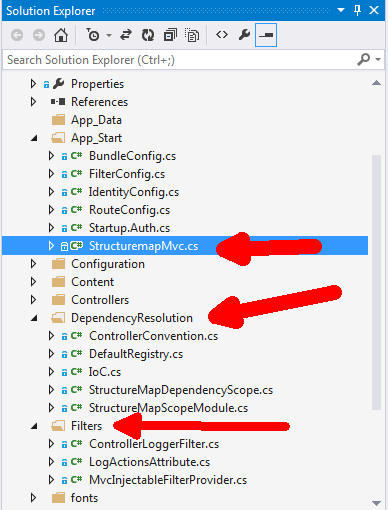i am facing issue in asp.net mvc custom acitonfilte using structuremap in my "LogAttribute" class i have setter dependency injection which is coming null when executing the "OnActionExecuted" Method of my customfilterclass which is "LogAttribute"
my LogAttribute Class code is
public class LogAttribute : ActionFilterAttribute
{
public ApplicationDbContext Context { get; set; }
public string Description { get; set; }
public LogAttribute(string description)
{
Description = description;
}
public override void OnActionExecuted(ActionExecutedContext filterContext)
{
var userId = filterContext.HttpContext.User.Identity.GetUserId();
var user = Context.Users.Find(userId); **i am getting error here the Context is coming null here**
Context.Logs.Add(new Log(user, filterContext.ActionDescriptor.ActionName,
filterContext.ActionDescriptor.ControllerDescriptor.ControllerName,
Description
)
);
Context.SaveChanges();
}
}
i creat another class from wheren i am passing value to the setter dependency property
public class StructureMapFilterProvider : FilterAttributeFilterProvider
{
private readonly Func<IContainer> _container;
public StructureMapFilterProvider(Func<IContainer> container)
{
_container = container;
}
public override IEnumerable<Filter> GetFilters(ControllerContext controllerContext, ActionDescriptor actionDescriptor)
{
var filters = base.GetFilters(controllerContext, actionDescriptor);
var container = _container();
foreach (var filter in filters)
{
container.BuildUp(filter.Instance);
yield return filter;
}
}
}
my dependency resolver class code is
public class StructureMapDependencyResolver : IDependencyResolver
{
private readonly Func<IContainer> _containerFactory;
public StructureMapDependencyResolver(Func<IContainer> containerFactory)
{
_containerFactory = containerFactory;
}
public object GetService(Type serviceType)
{
if (serviceType == null)
{
return null;
}
var container = _containerFactory();
return serviceType.IsAbstract || serviceType.IsInterface
? container.TryGetInstance(serviceType)
: container.GetInstance(serviceType);
}
public IEnumerable<object> GetServices(Type serviceType)
{
return _containerFactory().GetAllInstances(serviceType).Cast<object>();
}
}
and my global.ascx code is
public class MvcApplication : System.Web.HttpApplication
{
public IContainer Container
{
get
{
return (IContainer)HttpContext.Current.Items["_Container"];
}
set
{
HttpContext.Current.Items["_Container"] = value;
}
}
protected void Application_Start()
{
AreaRegistration.RegisterAllAreas();
FilterConfig.RegisterGlobalFilters(GlobalFilters.Filters);
RouteConfig.RegisterRoutes(RouteTable.Routes);
BundleConfig.RegisterBundles(BundleTable.Bundles);
DependencyResolver.SetResolver(new StructureMapDependencyResolver(() => Container ?? ObjectFactory.Container));
ObjectFactory.Configure(cfg =>
{
cfg.Scan(Scan =>
{
Scan.TheCallingAssembly();
Scan.WithDefaultConventions();
Scan.With(new ControllerConfiguration());
});
cfg.For<IFilterProvider>().Use(new StructureMapFilterProvider(() => Container ?? ObjectFactory.Container));
cfg.For<IUserStore<ApplicationUser>>()
.Use<UserStore<ApplicationUser>>();
cfg.For<DbContext>()
.Use(() => new ApplicationDbContext());
cfg.SetAllProperties(x =>
x.Matching(p =>
p.DeclaringType.CanBeCastTo(typeof(ActionFilterAttribute)) &&
p.DeclaringType.Namespace.StartsWith("TestingSturctureMap") &&
p.PropertyType.IsPrimitive &&
p.PropertyType != typeof(string)));
});
}
public void Application_BeginRequest()
{
Container = ObjectFactory.Container.GetNestedContainer();
}
public void Application_EndRequest()
{
Container.Dispose();
Container = null;
}
}

